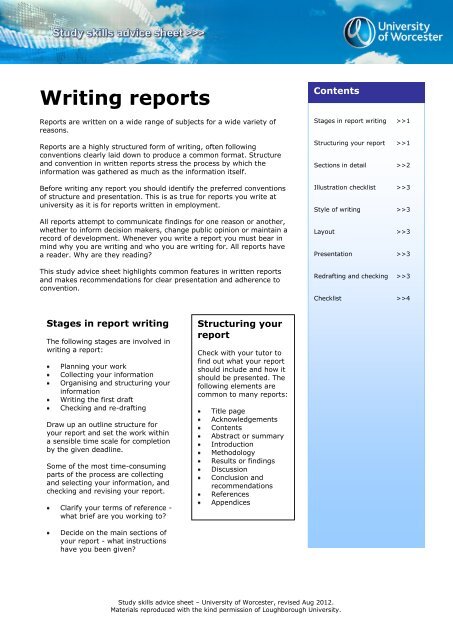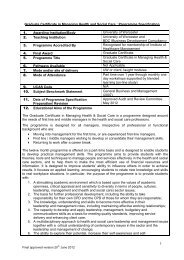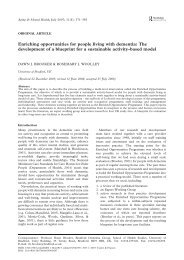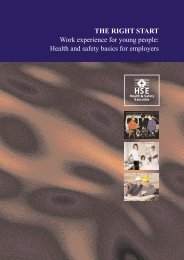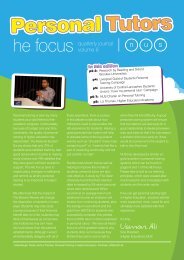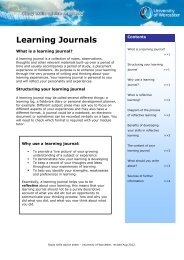Writing reports - University of Worcester
Writing reports - University of Worcester
Writing reports - University of Worcester
Create successful ePaper yourself
Turn your PDF publications into a flip-book with our unique Google optimized e-Paper software.
<strong>Writing</strong> <strong>reports</strong><br />
Reports are written on a wide range <strong>of</strong> subjects for a wide variety <strong>of</strong><br />
reasons.<br />
Reports are a highly structured form <strong>of</strong> writing, <strong>of</strong>ten following<br />
conventions clearly laid down to produce a common format. Structure<br />
and convention in written <strong>reports</strong> stress the process by which the<br />
information was gathered as much as the information itself.<br />
Before writing any report you should identify the preferred conventions<br />
<strong>of</strong> structure and presentation. This is as true for <strong>reports</strong> you write at<br />
university as it is for <strong>reports</strong> written in employment.<br />
All <strong>reports</strong> attempt to communicate findings for one reason or another,<br />
whether to inform decision makers, change public opinion or maintain a<br />
record <strong>of</strong> development. Whenever you write a report you must bear in<br />
mind why you are writing and who you are writing for. All <strong>reports</strong> have<br />
a reader. Why are they reading<br />
This study advice sheet highlights common features in written <strong>reports</strong><br />
and makes recommendations for clear presentation and adherence to<br />
convention.<br />
Contents<br />
Stages in report writing >>1<br />
Structuring your report >>1<br />
Sections in detail >>2<br />
Illustration checklist >>3<br />
Style <strong>of</strong> writing >>3<br />
Layout >>3<br />
Presentation >>3<br />
Redrafting and checking >>3<br />
Checklist >>4<br />
Stages in report writing<br />
The following stages are involved in<br />
writing a report:<br />
Planning your work<br />
Collecting your information<br />
Organising and structuring your<br />
information<br />
<strong>Writing</strong> the first draft<br />
Checking and re-drafting<br />
Draw up an outline structure for<br />
your report and set the work within<br />
a sensible time scale for completion<br />
by the given deadline.<br />
Some <strong>of</strong> the most time-consuming<br />
parts <strong>of</strong> the process are collecting<br />
and selecting your information, and<br />
checking and revising your report.<br />
Clarify your terms <strong>of</strong> reference -<br />
what brief are you working to<br />
Structuring your<br />
report<br />
Check with your tutor to<br />
find out what your report<br />
should include and how it<br />
should be presented. The<br />
following elements are<br />
common to many <strong>reports</strong>:<br />
Title page<br />
Acknowledgements<br />
Contents<br />
Abstract or summary<br />
Introduction<br />
Methodology<br />
Results or findings<br />
Discussion<br />
Conclusion and<br />
recommendations<br />
References<br />
Appendices<br />
Decide on the main sections <strong>of</strong><br />
your report - what instructions<br />
have you been given<br />
Study skills advice sheet – <strong>University</strong> <strong>of</strong> <strong>Worcester</strong>, revised Aug 2012.<br />
Materials reproduced with the kind permission <strong>of</strong> Loughborough <strong>University</strong>.
Sections in detail<br />
Title page<br />
This should include the title <strong>of</strong> the report (which<br />
should give a precise indication <strong>of</strong> the subject<br />
matter), the author's name, module, course<br />
and the date.<br />
Acknowledgements<br />
You should acknowledge any help you have<br />
received in collecting the information for the<br />
report, for example staff in your department,<br />
support services or external companies.<br />
Contents<br />
You should list all the main sections <strong>of</strong> the<br />
report in sequence with the page numbers they<br />
begin on. If there are charts, diagrams or tables<br />
included in your report, these should be listed<br />
separately under a title such as 'List <strong>of</strong><br />
Illustrations' together with the page numbers<br />
on which they appear.<br />
Abstract or summary<br />
This should be a short paragraph summarising<br />
the main contents <strong>of</strong> the report. It should<br />
include a short statement <strong>of</strong> the main task, the<br />
methods used, conclusions reached and any<br />
recommendations to be made. The abstract or<br />
summary should be concise, informative and<br />
independent <strong>of</strong> the report.<br />
Write this section after you have written the<br />
main body <strong>of</strong> the report.<br />
Introduction<br />
This should give the context and scope <strong>of</strong> the<br />
report and should include your terms <strong>of</strong><br />
reference (what have you been asked to find<br />
out). State your objectives clearly, define the<br />
limits <strong>of</strong> the report, outline the method <strong>of</strong><br />
enquiry, give a brief general background to the<br />
subject <strong>of</strong> the report and indicate the proposed<br />
development.<br />
Methodology<br />
In this section you should state how you carried<br />
out your enquiry. What form did your enquiry<br />
take Did you carry out interviews or<br />
questionnaires, how did you collect your data<br />
What measurements did you make How did<br />
you choose the subjects for your interviews<br />
Results or findings<br />
Present your findings in as simple a way as<br />
possible. The more complicated the<br />
information looks, the more difficult it will<br />
be to interpret. Graphs, charts and<br />
diagrams help your reader to identify key<br />
results and break the flow <strong>of</strong> written text.<br />
Discussion<br />
This is the section where you can analyse<br />
and interpret your results drawing from the<br />
information that you have collected,<br />
explaining its significance. Identify<br />
important issues and suggest explanations<br />
for your findings.<br />
Outline any problems encountered and try<br />
and present a balanced view.<br />
Conclusions and recommendations<br />
This is the section <strong>of</strong> the report, which<br />
draws together the main issues. It should<br />
be expressed clearly and should not present<br />
any new information. You may wish to list<br />
your recommendations in a separate<br />
section or include them with the<br />
conclusions.<br />
References<br />
It is important that you give precise details<br />
<strong>of</strong> all the work by other authors which has<br />
been referred to within the report.<br />
References are usually listed in alphabetical<br />
order <strong>of</strong> the authors' names but you need<br />
to check whether there has been a standard<br />
convention adopted by your department.<br />
Make sure that your references are accurate<br />
and follow a set format.<br />
Appendices<br />
An appendix contains additional related<br />
information which is not essential to read<br />
but can be consulted if the reader wishes.<br />
However the interpretation <strong>of</strong> the report<br />
should not depend on this being read. You<br />
could include details <strong>of</strong> interview questions,<br />
statistical data, a glossary <strong>of</strong> terms, or<br />
other such information.<br />
Study skills advice sheet – <strong>University</strong> <strong>of</strong> <strong>Worcester</strong>, revised Aug 2012.<br />
Materials reproduced with the kind permission <strong>of</strong> Loughborough <strong>University</strong>.
<strong>Writing</strong> for others<br />
Illustration checklist<br />
All illustrations should be carefully<br />
presented to help convey your<br />
information.<br />
Are all your illustrations clearly<br />
labelled<br />
Do they all have titles<br />
Is the link between the text and the<br />
diagram clear<br />
Are the headings precise<br />
Are the axes <strong>of</strong> graphs clearly<br />
labelled<br />
Can tables be easily interpreted<br />
Have you abided by copyright laws<br />
when including illustrations/tables<br />
from published documents<br />
Have you numbered your<br />
illustrations and listed them in the<br />
contents section<br />
Style <strong>of</strong> writing<br />
The message here is to keep it simple.<br />
Avoid sentences that are too long and<br />
eliminate unnecessary jargon.<br />
Your tutor will be able to advise<br />
whether the report should be written in<br />
the 'active' or 'passive' voice.<br />
The active voice reads as follows:<br />
'I recommend...'<br />
The passive voice reads:<br />
'It is recommended that...'<br />
The active voice allows you to write<br />
short, punchy sentences. The passive<br />
appears more formal and considered<br />
and is more suitable for academic<br />
writing. Avoid mixing the two voices.<br />
Find out in which voice you will be<br />
expected to write.<br />
Layout<br />
Most <strong>reports</strong> have a progressive<br />
numbering system. The most common<br />
system is the decimal notation system:<br />
The main sections are given single arabic<br />
numbers - 1, 2, 3 and so on.<br />
Subsections are given a decimal number -<br />
1.1, 1.2, 1.3 and so on.<br />
Sub-sections can be further divided into -<br />
1.11, 1.12, 1.13 and so on.<br />
Presentation<br />
Your report should be easy to read.<br />
Usually your department will ask for it to<br />
be word-processed.<br />
What are the requirements for your<br />
department or module<br />
Leave wide margins for binding and<br />
feedback comments from your tutor.<br />
Avoid rambling by using short<br />
sentences.<br />
Paragraphs should be short and<br />
concise.<br />
Avoid using unnecessary jargon and<br />
unexplained abbreviations.<br />
List your standard measurements,<br />
units and technical terminology in a<br />
glossary at the end.<br />
Headings should be clear - highlighted<br />
in bold or underlined.<br />
Label graphs, pictures or drawings as<br />
'Figures', e.g. Figure 1, Figure 2 etc.<br />
Tables <strong>of</strong> information should be<br />
labelled separately, e.g. Table 1,<br />
Table 2 etc.<br />
Redrafting and checking<br />
Once you have written the first draft <strong>of</strong><br />
your report you will need to check it<br />
through. It is probably sensible to leave it<br />
on your desk for a day or so if you have<br />
the time. This will make a clear break<br />
from the intensive writing period, allowing<br />
you to view your work more objectively.<br />
Assess your work by re-reading<br />
particularly focusing on:<br />
Structure<br />
Content<br />
Style<br />
Use the checklist overleaf to check<br />
through your report before submitting it.<br />
Study skills advice sheet – <strong>University</strong> <strong>of</strong> <strong>Worcester</strong>, revised Aug 2012.<br />
Materials reproduced with the kind permission <strong>of</strong> Loughborough <strong>University</strong>.
Further information<br />
This Study Advice Sheet has been<br />
produced by Student Services at<br />
UW.<br />
We support student learning across<br />
the <strong>University</strong> through the<br />
publication <strong>of</strong> materials such as<br />
these.<br />
Other study advice sheets that you<br />
may find useful include:<br />
Essay writing<br />
Learning at university<br />
Learning journals<br />
Making oral presentations<br />
Minimising stress<br />
Organising yourself<br />
Plagiarism & referencing<br />
Reading efficiently<br />
Revision and exam skills<br />
Study at a distance<br />
Taking notes<br />
Using feedback to improve your<br />
work<br />
What does the question mean<br />
Working in groups<br />
All study advice sheets are available<br />
to view and download on the<br />
following website:<br />
www.worcester.ac.uk/studyskills<br />
or you can follow the links from<br />
your SOLE page.<br />
You may also find it useful to check<br />
out the ‘Moving On’ pack,<br />
accessible from the link on your<br />
SOLE page.<br />
‘Moving On’ is a study skills<br />
package specifically designed to<br />
help you prepare for Higher<br />
Education & to become a successful<br />
student.<br />
Contact: studyskills@worc.ac.uk<br />
Report <strong>Writing</strong> Checklist<br />
Title page<br />
Does this include the: Title<br />
Author's name<br />
Module/course details<br />
Acknowledgements<br />
Have you acknowledged all sources <strong>of</strong> help<br />
Contents<br />
Have you listed all the main sections in sequence<br />
Have you included a list <strong>of</strong> illustrations<br />
Abstract or summary<br />
Does this state: The main task<br />
The methods used<br />
The conclusions reached<br />
The recommendations made<br />
Introduction<br />
Does this include:<br />
Methodology<br />
Does this include:<br />
Reports and findings<br />
Are your diagrams clear and simple<br />
Are they clearly labelled<br />
Do they relate closely to the text<br />
Your terms <strong>of</strong> reference<br />
The limits <strong>of</strong> the report<br />
An outline <strong>of</strong> the method<br />
A brief background to the subject matter<br />
The form your enquiry took<br />
The way you collected your data<br />
Discussion<br />
Have you identified key issues<br />
Have you suggested explanations for your findings<br />
Have you outlined any problems encountered<br />
Have you presented a balanced view<br />
Conclusions and recommendations<br />
Have you drawn together all <strong>of</strong> your main ideas<br />
Have you avoided any new information<br />
Are any recommendations clear and concise<br />
References<br />
Have you listed all references alphabetically<br />
Have you included all the necessary information for locating each<br />
reference<br />
Are your references accurate<br />
Appendices<br />
Have you only included supporting information<br />
Does the reader need to read these sections<br />
<strong>Writing</strong> style<br />
Have you used clear and concise language<br />
Are your sentences short and jargon free<br />
Are your paragraphs tightly focused<br />
Have you used the active or the passive voice<br />
Study skills advice sheet – <strong>University</strong> <strong>of</strong> <strong>Worcester</strong>, revised Aug 2012.<br />
Materials reproduced with the kind permission <strong>of</strong> Loughborough <strong>University</strong>.


